Riding an electric bike can feel like soaring through the city, effortlessly gliding past traffic. But before you can take flight, you need to know how much it will cost. Just like a compass guiding your way, this article will provide you with the data-driven insights you need.
We’ll explore the different types of electric bikes available, delve into motor power and performance, and analyze battery capacity and technology.
Get ready to calculate your budget and embark on your electrifying journey.
Key Takeaways
- Electric bikes come in a range of price points, with entry-level bikes costing around $500-$1,000, mid-range bikes costing $1,000-$3,000, and high-end bikes costing $3,000 and above.
- Entry-level electric bikes offer basic features and benefits such as a lightweight frame, reliable motor, and decent battery life. They are priced around $1,000 and provide reduced environmental impact, improved fitness, and the ability to cover longer distances.
- Mid-range electric bikes offer better components and performance, including a more powerful motor, longer battery range, and enhanced suspension. They also have advanced braking systems and higher-quality components. These bikes provide convenient transportation, reduced carbon footprint, and cost savings.
- High-end electric bikes are top-of-the-line and come with enhanced battery performance for longer rides and faster speeds. They feature premium components for durability and smooth operation, as well as advanced suspension systems for comfortable rides on rough terrain. These bikes are ideal for those seeking the best performance and comfort.
Types of Electric Bikes
If you’re looking for different types of electric bikes, you’ll find a wide range of options to choose from. When considering electric bike maintenance, it’s important to choose the right electric bike for your needs.
There are various types of electric bikes available, each designed for specific purposes. Commuter electric bikes are ideal for city dwellers who need a reliable and efficient mode of transportation. These bikes often come with features like fenders, lights, and racks for added convenience.
For off-road adventures, mountain electric bikes are a popular choice, equipped with robust tires and suspension systems for tackling rough terrains. Folding electric bikes are perfect for those who need a compact and portable option for commuting or traveling.
Hybrid electric bikes combine the features of road bikes and mountain bikes, offering versatility for different riding conditions. Understanding the different types of electric bikes will help you choose the right one based on your preferences and requirements.
Transitioning into the next section, motor power and performance play a crucial role in the overall riding experience.
Motor Power and Performance
To get the best motor power and performance, you should consider opting for a higher wattage motor. Higher wattage motors generally provide more torque and acceleration, allowing you to easily tackle hills and rough terrain. Additionally, a higher wattage motor can help you reach higher speeds, which can be especially useful if you plan to ride on roads with higher speed limits.
However, it’s important to note that higher wattage motors may drain the battery faster, so you should also consider the battery capacity and technology when choosing an electric bike. Motor efficiency is another important factor to consider, as a more efficient motor will provide better overall performance and longer battery life.
Considering both motor power and efficiency, as well as speed limit regulations, will ensure you choose an electric bike that meets your specific needs and preferences.
Moving on to battery capacity and technology, it’s important to consider…
Battery Capacity and Technology
When considering an electric bike, it’s important to take into account the battery capacity and technology. The battery life of an electric bike determines how far you can ride before needing to recharge. This is crucial if you plan on using your bike for longer commutes or extended rides.
Additionally, the charging infrastructure in your area is essential as it affects the convenience of recharging your bike’s battery. Here are three key factors to consider:
-
Battery Capacity: The higher the capacity, the longer the battery will last before needing a recharge. Look for bikes with larger battery capacities if you require longer rides without interruptions.
-
Battery Technology: Lithium-ion batteries are commonly used in electric bikes due to their high energy density, long lifespan, and quick charging capabilities. Consider bikes with advanced battery technology for optimal performance.
-
Charging Infrastructure: Check if there are easily accessible charging stations or outlets in your area. This ensures that you can conveniently recharge your bike’s battery when needed.
Considering the battery capacity, technology, and charging infrastructure will help you make an informed decision about the electric bike that suits your needs.
In the next section, we will discuss the importance of frame and design in choosing the right electric bike.
Frame and Design
Consider the frame and design of your electric bike to ensure it suits your preferences and needs.
Customizable options for electric bike frames are available, allowing you to choose the size and style that fits you best. Whether you prefer a step-through frame for easy mounting and dismounting or a traditional diamond frame for a sportier look, there are options to accommodate your taste.
Additionally, ergonomic design is crucial for electric bikes as it ensures comfort and proper body alignment during rides. Look for features such as adjustable handlebars and saddles, as well as a well-positioned center of gravity. These elements enhance stability and reduce strain on your body, allowing for longer and more enjoyable rides.
Transitioning into the subsequent section about components and accessories, it’s important to consider how these elements contribute to the overall performance and functionality of your electric bike.
Components and Accessories
The components and accessories on your e-bike greatly impact its performance and functionality. When it comes to electric bike accessories, there are several popular options to consider.
-
Light System: A high-quality light system ensures visibility during night rides, enhancing safety.
-
Suspension: A good suspension system provides a smoother and more comfortable ride, especially on rough terrains.
-
Motor: The motor is the heart of an electric bike. A powerful and efficient motor determines the bike’s speed and climbing ability.
-
Battery: The battery is crucial for the range and overall performance of your e-bike. Opt for a long-lasting and fast-charging battery for convenience.
These components, along with other accessories like racks, fenders, and bike locks, contribute to the overall value and usability of your electric bike.
Considering these factors, it’s essential to choose components and accessories that meet your specific needs.
Transitioning into the subsequent section about brand reputation and quality, it’s crucial to evaluate these factors before making a final decision.
Brand Reputation and Quality
Brand reputation and quality are important factors to consider when choosing components and accessories for your e-bike. Brand reputation refers to the overall perception and trustworthiness of a particular brand, while quality refers to the durability, performance, and reliability of the products.
It is crucial to research and read customer reviews to gauge the experiences of other users with different brands. Look for brands that have a strong reputation for producing high-quality components and accessories. Customer reviews provide valuable insights into the satisfaction levels, potential issues, and overall performance of the products.
By considering brand reputation and customer reviews, you can make an informed decision and ensure that you are investing in components and accessories that are reliable and well-regarded.
Moving on to additional features, there are several factors to consider…
Additional Features
When looking for components and accessories for your e-bike, it’s important to think about the additional features that can enhance your riding experience.
Electric bike customization allows you to personalize your ride and make it uniquely yours. Some popular customization options include adjustable suspension forks, ergonomic grips, and custom paint jobs.
Safety features are also crucial when it comes to riding an electric bike. Look for bikes that come with integrated lights for better visibility, hydraulic disc brakes for reliable stopping power, and puncture-resistant tires for added durability. Additionally, consider features like a built-in alarm system or GPS tracking for added security. These additional features not only improve your safety but also provide a more comfortable and enjoyable riding experience.
Transitioning into the next section about price range and budget considerations, it’s important to also consider the cost of these additional features when determining your overall budget.
Price Range and Budget Considerations
When considering the price range and budget considerations for electric bikes, there are three key categories to explore: entry-level electric bikes, mid-range electric bikes, and high-end electric bikes.
Entry-level electric bikes typically range from $500 to $1,000 and offer basic features and functionalities.
Mid-range electric bikes, on the other hand, fall between $1,000 and $3,000 and provide better quality components and greater performance.
Finally, high-end electric bikes can cost upwards of $3,000 and boast top-of-the-line features, cutting-edge technology, and exceptional build quality.
Entry-level Electric Bikes
An entry-level electric bike typically costs around $1,000. These bikes are designed to provide a cost-effective option for those who are new to the world of electric bikes.
While the price may be lower compared to other models, entry-level electric bikes still offer a range of features that make them a great choice for riders. Some of these features include a lightweight frame, a reliable motor, and a decent battery life.
Electric bikes in this price range also offer benefits such as reduced environmental impact, improved fitness, and the ability to cover longer distances without getting tired.
As we transition into the next section about mid-range electric bikes, it’s important to note that these bikes offer even more advanced features and higher performance levels.
Mid-range Electric Bikes
Now that we’ve explored entry-level electric bikes, let’s move on to the next tier: mid-range electric bikes.
These models offer a step up in terms of features and performance. With a mid-range electric bike, you can expect a more powerful motor, a longer battery range, and enhanced suspension for a smoother ride. These bikes often come equipped with advanced braking systems and higher-quality components, ensuring a reliable and comfortable experience on various terrains.
In addition to their improved performance, mid-range electric bikes also offer several benefits. They provide a convenient and eco-friendly mode of transportation, allowing you to cover longer distances without breaking a sweat. They also help reduce your carbon footprint and save money on fuel costs.
As we delve into the next section on high-end electric bikes, you’ll discover even more exciting features and capabilities.
High-end Electric Bikes
Moving up to the next tier, high-end electric bikes offer even more advanced features and capabilities. These top-of-the-line bikes are designed for those who demand the best in performance and technology.
Here are some key features of high-end electric bikes:
- Enhanced Battery Performance: High-end electric bikes often come with larger and more powerful batteries, allowing for longer rides and faster speeds.
- Premium Components: These bikes are equipped with top-quality parts and components, ensuring durability and smooth operation.
- Advanced Suspension Systems: High-end electric bikes usually feature advanced suspension systems, providing a comfortable and controlled ride, even on rough terrain.
Investing in a high-end electric bike comes with several benefits. You can enjoy a more powerful and efficient ride, increased range, and superior comfort. These bikes are built to last, offering a higher level of reliability and performance.
As we transition into the next section about maintenance and repair costs, it is important to consider the long-term value that high-end electric bikes provide.
Maintenance and Repair Costs
The maintenance and repair costs of an electric bike can vary depending on the brand and model. When it comes to maintenance costs, you may need to consider regular tune-ups, battery replacements, and tire changes. These expenses can range from $50 to $200 per year, depending on the specific needs of your electric bike.
Repair expenses, on the other hand, can be more unpredictable and can depend on the extent of the damage and the availability of replacement parts. On average, you can expect to spend around $100 to $300 for minor repairs, while major repairs can cost upwards of $500. It is important to note that these costs are estimates and can vary depending on the specific circumstances.
Transitioning into the subsequent section about ‘financing and purchase options’, it is essential to consider these maintenance and repair costs when making your decision.
Financing and Purchase Options
One option for financing and purchasing an electric bike is to consider different payment plans and options offered by retailers. Financing options for electric bikes can vary depending on the retailer and your credit score. Some retailers offer financing plans with low interest rates, allowing you to pay off the bike over a set period of time. This can be a convenient option if you don’t have the funds upfront but still want to own an electric bike.
Another option is to compare purchase options for electric bikes. Some retailers may offer discounts or promotions during certain times of the year, making it more affordable to buy an electric bike. Additionally, you can explore second-hand electric bike options, which can be a more cost-effective choice.
Overall, it’s important to evaluate different financing and purchase options to find the best deal for your needs and budget.
Frequently Asked Questions
What are the benefits of using an electric bike compared to a regular bicycle?
Compared to a regular bicycle, using an electric bike offers numerous benefits. It provides a cost-effective transportation option with lower maintenance expenses and allows you to travel faster and farther. Additionally, electric bikes have a reduced environmental impact due to their zero-emission operation.
How long does it typically take to charge the battery of an electric bike?
On average, charging an electric bike’s battery takes about 3-6 hours. The charging time may vary based on the battery capacity, but it’s important to note that this process is relatively quick and convenient.
Are electric bikes allowed on bike paths and trails?
Electric bikes are subject to safety regulations when it comes to using bike paths and trails. Many jurisdictions allow them, but specific rules may vary. In terms of environmental impact, electric bikes help reduce carbon emissions and promote sustainable transportation.
Can I use an electric bike in hilly areas or off-road terrains?
Electric bikes are perfect for hilly areas and off-road terrains, providing you with the power and control you need. With regular electric bike maintenance and top brands like Bosch and Shimano, you’ll have a reliable and thrilling ride.
Are there any government incentives or subsidies available for purchasing an electric bike?
Yes, there are government incentives and subsidies available for purchasing an electric bike. These incentives can help offset the cost and make electric bikes more affordable compared to traditional bikes.
Conclusion
In conclusion, when it comes to the cost of electric bikes, it’s important to consider various factors.
Just like choosing a vehicle, you need to assess the types, motor power, battery capacity, frame design, components, and additional features. These elements determine the price range and should be considered within your budget.
Remember that maintenance and repair costs may also come into play. To make the most informed decision, explore financing and purchase options.
Like a wise traveler navigating through a bustling marketplace, carefully consider these factors to find the perfect electric bike that suits both your needs and wallet.
















